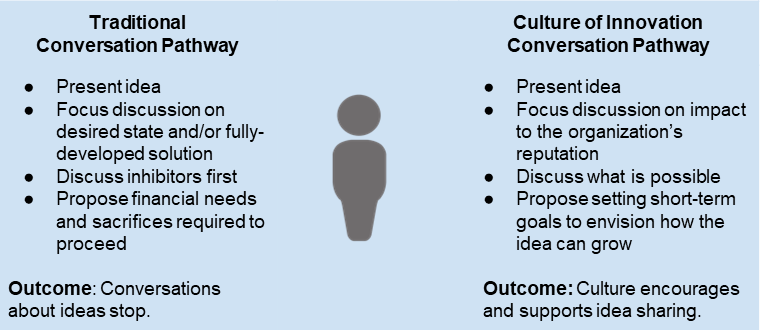IT organizations, teams, and even just one person can foster cultures of innovation.

Creating a "culture of innovation" can start with one person. Cultures of innovation allow considerable freedom in deciding how work should be organized and how tasks should be carried out. These cultures value commitment, creative risk-taking, crowdsourcing, and communication. When one person takes the initiative and demonstrates that all ideas are needed and welcomed, that person creates a safe space for peers to come forward and share ideas. These conversations are guided by focused communication strategies that (1) eliminate inhibitors through the early exchange of ideas and (2) limit conversations to discuss what can be done rather than what cannot be done. By embracing the concept of "it takes only one," combined with an improved communication strategy, the culture creates innovation ambassadors.
We have identified five ways an IT organization or team, and even just one person, can foster a culture of innovation.
1: Focus on Continuous Improvement
Definitions of the word innovation include "a new idea, method, or device" and "the introduction of something new."Footnote1 The act of creating something new is often intimidating and can lead to a lack of confidence when sharing ideas. This pressure can develop into a creative block or lack of inspiration. The concept of continuous improvement focuses on uninterrupted ideas to build upon an existing process. As for the word continuous, one definition is "going on without stopping."Footnote2 If the culture of an IT organization were to focus on continuous improvements without interrupting ideas in the process, what would the result be? By constantly moving and establishing ideas, a team can develop processes that will evolve over time, as well as through spontaneous breakthroughs.
With a focus on continuous improvement, the culture mindset can incorporate the following three Cs:
- Comfort in talking about what doesn't work
- Contributing to ownership of the problem-solving
- Creative thinkers who engage with strategists
The result is a "C what we can do better" environment.
2. Create a Value Statement
A value statement lists the core principles that guide and direct an organization and its culture. These values influence decision-making and establish standards to direct the organization toward its goals. A clear value statement can create a cohesive culture that fosters inclusiveness with all ideas welcomed. The value statement is an accompaniment to the mission statement (which defines the service or business provided, objectives, and the approach to reach those objectives) and the vision statement (which discusses the desired future state and addresses why the organization provides its service). Working together, the mission, vision, and value statements provide the holistic framework to guide the development of a culture of innovation.
3. Incorporate the Core Competencies of Innovative Organizations
Innovative organizations look for high-demand skills when they are seeking top talent. Although some professional development courses include or touch on the topics below, offering programs that focus specifically on these core competencies will reinforce that "innovation" is valued as a cultural standard.
- Resiliency and growth; a grit mindset
- Customer-centered innovation using feedback and evaluations from users
- Inclusivity
- Collaborative and effective communication
- Informed decision-making
- Results-driven
4. Emphasize Culture As the Heart of Innovation
Employees at all levels within the IT organization have the same intrinsic need: the desire for authentic purpose in their work. However, according to a July-September 2020 Gallup poll, 51 percent of workers stated that they are "not engaged" at work and disclosed that they are "psychologically unattached to their work and company."Footnote3
Clearly, the data tells the story that desire for purpose at work is not being met and that culture is the key. Perhaps by leveraging the values included in the IT organization's value statement and combining those values with the "C what we can do better" approach, IT teams can achieve their need for purpose, as well as professional growth. The hoped-for outcome is organizations with happy, passionate, and motivated employees who are vested in and committed to brand loyalty.
5: Change the Method of Discussing Ideas
Intentional communication strategies that support inclusivity and belongingness and that stimulate new ideas are crucial to a culture of innovation. Discussions are often about why an idea would ultimately be ineffective or how it may have been unsuccessful in the past. Sometimes the conversation digresses altogether and becomes a listing of inhibiting factors. When the focus shifts to the "C what we can do better" approach, inhibiting factors can be discredited as required. Changing how new ideas are discussed, with a focus on how innovative concepts will affect the reputation of the organization, creates a pathway to continuous improvement. Rather than beginning from a place of "we can't do that," teams can consider potential ideas and their benefits from a place of "how might we do that?" Figure 1 shows the traditional versus the culture of innovation conversation pathways.

It Takes Only One
Because it takes only one person to inspire change, anyone at any level in the organization can create a culture of innovation, even from within a single team. Here are some additional ways that individuals can get started:
- Be someone's wing person: invite them to share an idea that would make an improvement to an existing service or process.
- Share ideas inside and outside of the organization with those who will listen, and in return, listen to the suggestions of others.
- Discuss the ways an innovation will affect the reputation of the organization.
- Share the intentional communication framework to guide the conversation, and hold a separate follow-up discussion to explore inhibitors and ensure that all perspectives have time to develop.
- Empower the team to think creatively, without reservation, by sharing ideas in forums where no decisions will be made in the first discussion/read.
Organizations with successful cultures of innovation have a single factor in common: anyone who is interested can contribute to the solution. Organizations have found that that innovation thrives when strategists collaborate with both creative thinkers and communicators.
Notes
- Merriam-Webster.com, "innovation." Jump back to footnote 1 in the text.
- Merriam-Webster.com, "continuous" (kids definition). Jump back to footnote 2 in the text.
- Jim Harter, "U.S. Employee Engagement Reverts Back to Pre-COVID-19 Levels," Gallup Workplace, October 16, 2020. Jump back to footnote 3 in the text.
Teri Abbo is the Director of IT Services Alliance at Oakland University.
Amy Pelkey is the IT Services Coordinator at Oakland University.
© 2022 Teri Abbo and Amy Pelkey. The text of this work is licensed under a Creative Commons BY 4.0 International License.
